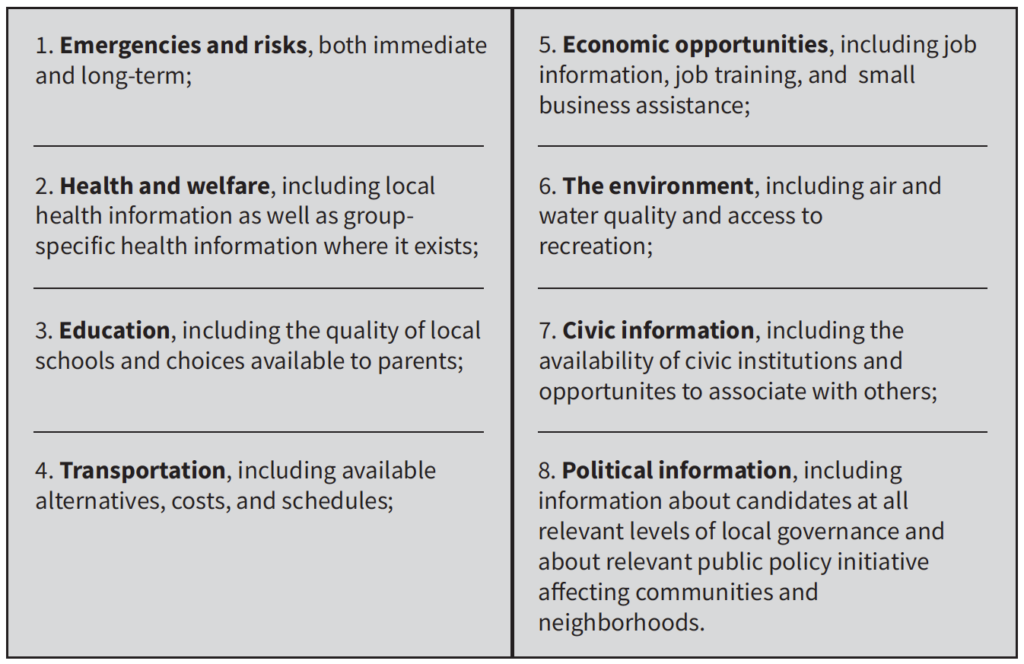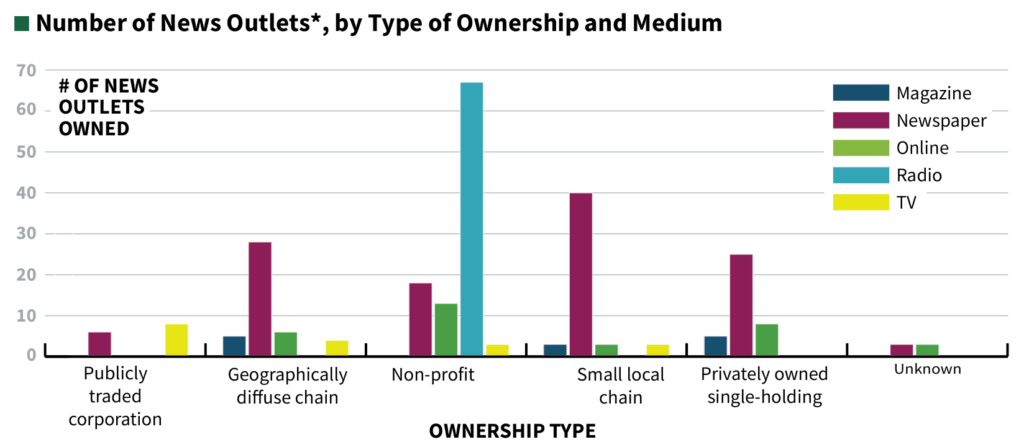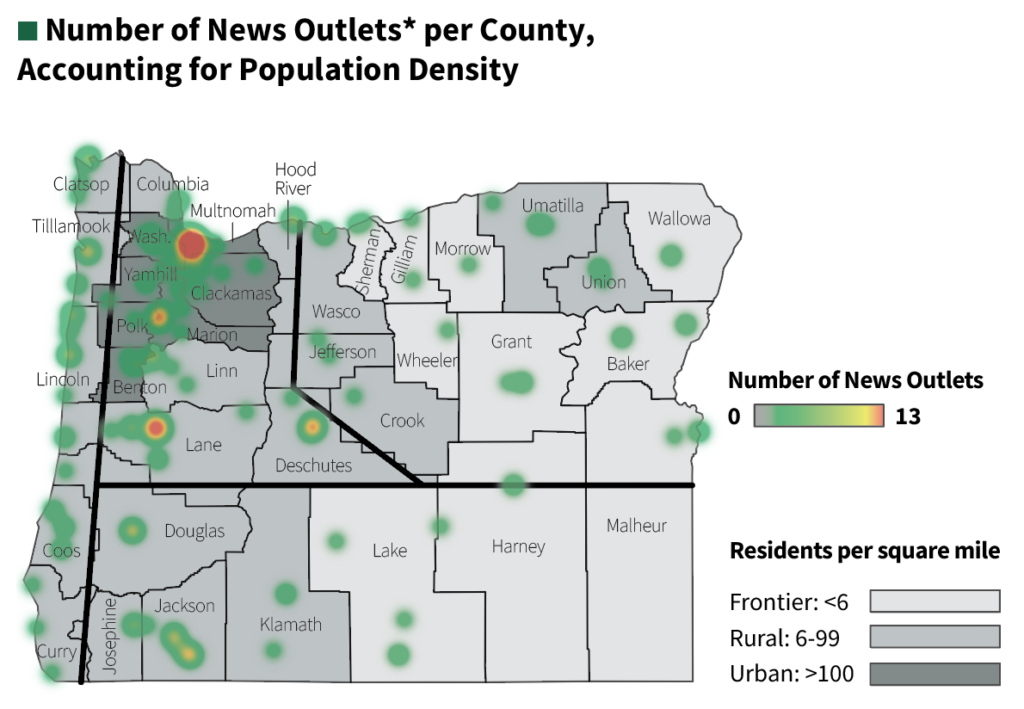To create a snapshot of Oregon’s local news infrastructure, we conducted original research from July 2021 to August 2022 designed to identify all outlets around the state that regularly produce originally reported news about state and/or local public affairs. Here, we first describe how we identified these outlets. Then we present descriptive data on the types and ownership of Oregon’s news outlets, where they are concentrated, and where they are lacking.
We compiled our database from several sources, beginning with the Cision database of media outlets in Oregon.1 Cision is a for-profit company that maintains a database of active media organizations, based on information provided by those organizations. While it provides a strong starting place for local news ecosystem mapping, the database has gaps due to organizations not providing or updating their information. We supplemented information found in Cision with information from other organizations, including the US News Deserts project, the Oregon Newspaper Publishers Association, Project Oasis, the Institute for Nonprofit News, the American Journalism Project, Poynter, as well as through our personal and professional networks. This research yielded a database consisting of 645 media outlets, including newspapers, magazines, online news, radio stations, and television stations based in Oregon.2 Some communities in Oregon are served by news media outlets from beyond the state’s borders (for example, people living in Ontario, Oregon may receive news from local outlet Argus Observer as well as from out-of-state television station KBOI (of Boise, ID), despite this outlet having limited coverage of Ontario news), while in some areas of the state, like the Portland metro area, news from across the Washington border can be highly relevant. For clarity’s sake, we decided to limit this initial ecosystem assessment to news outlets based in Oregon.
Not all locally-based media outlets necessarily produce local news, however. Most notably, commercial radio stations (those that are operated for-profit, which distinguishes them from “public” or “community” radio stations) generally carry limited news programming at best3 Abernathy, “News deserts…”, p. 67; Mahone, et al, “Who’s Producing Local Journalism…”, p. 3., whereas local newspapers, local television, and public and community radio stations are more likely to include original, local news content.4 A recent study noted that “The average amount of weekday local TV news programming increased slightly in 2020….. Local TV stations dedicated an average of 6.2 hours to news programming per weekday in 2020, up slightly from 5.9 hours in 2018 and 2019.” Pew Research Center, “Local TV news…”; see also Abernathy, “News deserts…”, p. 84. And, as discussed above, some sites that look like traditional news outlets actually do not independently produce news at all, but rather, package press releases and algorithmically-generated content.
Therefore, to winnow our initial set of media outlets, we created a more refined subset of the database, based on two steps. First, we excluded for-profit commercial radio stations from this subset, while retaining public and community radio stations. (Public radio is an important component of the news ecosystem, since 95% of American households can receive its over-the-air signals, and particularly important to local news in Oregon, which in 2020 was ranked eighth nationally in terms of its number of public radio outlets.)5 Abernathy, “News deserts,” p. 50.
Second, we took a closer look at the content provided by the remaining outlets, once commercial radio was set aside. Two coders independently judged whether each outlet a) appears to publish at least some local news content at least monthly, and b) produces original local journalism c) covering issues of local civic relevance.6 According to the second criterion, we did not count job postings or calendars of events for example, as “original journalism.” This emphasis on producing truly local original reporting is important, and also potentially creates a high threshold for inclusion in our database, given recent research suggesting that only a fraction of news content found in local media outlets is actually about local areas.7Laura Hazard Owen, “An analysis of 16,000 stories, across 100 U.S. communities, finds very little actual local news,” Nieman Lab (10 August 2018).
Our emphasis on local civic relevance creates a more selective subset of news outlets that are most actively contributing to Oregon’s civic life. Civically-relevant local news fulfills broadly important information needs of communities, including information about matters of health and safety, education, economic opportunities, the environment, and politics and policy.8While various rubrics have been developed for measuring the civic relevance of news content, most converge around shared elements such as those articulated in a comprehensive and influential report by the Federal Communications Commission: content that helps residents learn about and participate in their community, work together to address shared problems, “make wise decisions that will affect the quality of their lives” and “live safe and healthy lives.” See Federal Communications Commission, “The Information Needs of Communities,” (July 2011). These included a broad range of stories including those about local government and politics, philanthropy and volunteering, environment, education, health, fire and other emergencies, crime, courts and law, economic issues, transportation, development and real estate, housing, diversity and inclusion, and poverty and inequities. As a practical example of this third criterion, we counted stories profiling local businesses or artists as civically relevant, but stories recommending wines, restaurants, or other products or businesses for consumers to try would not count as civically relevant news.
(For a more extensive description of our methodological decision and coding processes, see the Methods appendix.)
Critical Information Needs for Local Communities
According to the FCC, all U.S. residents need access — in a timely manner, in an interpretable language, and via reasonably accessible media — to factual, nonpartisan information in eight essential categories:

This winnowing process yielded a subset of 241 local news outlets around the state that appear to be regularly producing original, local, civically relevant news. These outlets are the basis of the analysis presented below.9 Note that these selection criteria filter out online news aggregator sites, such as Jacksonville Review & Eugene Daily News, which may feature local news but do not appear to produce local news themselves. Also note that due to resource constraints, we did not systematically search for social media pages maintained by outlets in the dataset. This analysis and the subset of news outlets on which it is based should be looked at as a potentially incomplete snapshot of the current state of local news in Oregon.

It’s important to note that while the maps shown below indicate where these news outlets are physically located, and that they do offer some kind of regularly-produced news about Oregon, being pictured on the map does not necessarily indicate that an outlet is frequently producing news specifically about its immediate locale. Because of limited resources, as described above, outlets may struggle to cover their own immediate communities in depth. Future research should be conducted to answer this question.

It’s also important to note the potentially important news sources that our method cannot account for, such as the role played by community organizations, or libraries, or local bloggers, or even by free-lance journalists doing local reporting primarily via social media. A longer-term goal is to build out this database to encompass a broader range of sources of local news and information.
Characteristics of Oregon’s Local News Outlets
Types of local news outlets across the state. Our database shows that newspapers comprise 49% of news outlets in Oregon (defined by the criteria above), followed by radio stations (27.8%). Online only news outlets comprise 12% of the media outlets in our dataset. It is likely that more online news sources exist in Oregon that could reasonably meet our criteria, but given the limitations on the datasets we sourced (see Methods appendix) and the infeasibility of accounting for all Oregon based websites and social media accounts, we present a conservative estimate. Finally, television (6.64%) and magazines (4.56%) make up just over one-tenth of Oregon’s outlets regularly producing original local news.

Frequency of publication. Just under half of Oregon’s news outlets publish/broadcast daily (48.5%) and one-third publish weekly (32%). The predominance of daily and weekly content production reflects the fact that newspapers and radio stations make up the bulk of the dataset. The remaining quarter of content is distributed across monthly production and other frequencies (e.g., 2x/month or 2x/week).

* Number of local outlets regularly producing original local news content as of August 2022. See the Interactive Database and Methods Appendix for more details.
Ownership structure. We identified the ownership type of all 241 outlets in our final database by examining each outlet’s website or, when necessary, searching the Internet for information on their ownership. Using this method, 239 outlets had identifiable owners/funding sources. We categorized ownership into five types, expanding upon prior research studies:10 See Johanna Dunaway and Regina G. Lawrence, “What predicts the game frame? Media ownership, electoral context, and campaign news,” Political Communication 32, no. 1 (2015), pp. 43-60. The ownership categories shown here built on the work of Dunaway and Lawrence, though we added a non-profit category.
- Publicly traded and shareholder controlled corporation
- Large geographically diffuse chain
- Non-profit
- Small local chain owned in Oregon
- Privately-owned single-media holding
Of these 241 media outlets, 41.5% describe themselves as nonprofits. The prominence of nonprofit outlets in our data is related to our decision to exclude commercial radio stations, meaning that 100% of all radio stations in our database are nonprofits.
The remaining outlets are relatively evenly distributed across ownership models: Privately owned single-holdings, small local chains, and large geographically diffuse chains each make up between 15-18% of the dataset – that is, 36 to 43 outlets in each category. Publicly traded corporations make up a smaller portion of news outlets producing original local news in Oregon, comprising just about 5% of the dataset.11 Two outlets’ owners (New School and Wheeler County News) could not be determined.
Among other things, these data illustrate the continuing importance of newspapers in Oregon’s local news ecosystem, and also highlight the importance of non-profit media, particularly public radio. And the data show that a significant portion of outlets that regularly produce local news content are non-profits, privately-held single properties, or part of small, locally-owned chains.12Further analysis shows there is a significant association between medium and ownership type in Oregon (χ2(20) = 221.88, p < .000.). Television stations in Oregon are particularly likely to be owned by publicly-traded corporations; radio stations that produce local news are particularly likely to be non-profits (again, this finding reflects our methodological choices), and most small local chains in Oregon are newspaper outlets.
Where Oregon’s news outlets are located. The 241 media outlets we identified that regularly produce original local news (based on the criteria described above) are located in 97 different Oregon cities. Figures 3 and 4 illustrate how they are distributed around the state. Additionally, Table 2 lists the number of news outlets by county. The data indicate that eight Oregon counties have just 1-2 local news outlets each.

The map above consists of three layers:
- County-level population density: In gray-scale, counties are represented as either frontier, rural, or urban. This classification is adapted from Oregon Health & Science University and the Oregon Office of Rural Health. Including this layer sheds light on how well the density of news outlets matches (or does not match) the density of county-level populations in Oregon.
- Regional dividing lines: These lines segment Oregon into four rough geographic regions: Southern Oregon, Eastern Oregon, Coastal Oregon, and Metro/Valley, following a categorization developed for survey research by the Oregon Values and Beliefs Center.
- City-level heat mapping: News outlets are marked by the city where they’re based, with a gradient indicating how concentrated outlets are in that city/metropolitan area (green indicating less concentrated and red indicating more concentrated).
(More information about the specifics of the map (e.g., population density ranges, regional divisions by county) can be found in the Methods appendix.)
Together, the data show that access to local news is unevenly distributed across the state. Areas with higher population density tend to have more news outlets serving them–a pattern identified in studies of other locations around the U.S.13 Usher, News for the Rich, White, and Blue, p. 81. The areas of the state with lower population density are also geographically large, however, meaning that it can be harder for the few news outlets covering those areas to effectively cover all communities. The uneven distribution of outlets regularly producing original local news also means that, for some communities, if even one area outlet is at risk of shrinking or disappearing altogether, the impact for those communities is greater.
Indeed, our data also confirm that some Oregon counties have very little access to original local news. Our findings align with the US News Deserts project’s conclusion that Sherman County is a “news desert” lacking a local newspaper,14 Abernathy, “News deserts.” since the county is served by just two OPB rebroadcasting stations (KOTD in Biggs Junction and KOPB in Rufus).15 It’s important to note that despite the lack of any journalistic news organization serving that county, there may still be local news circulated there. For example, a Facebook group called “SCON..Sherman County, Oregon NEWS” seeks to “fill the void of E NEWS” in Sherman County and currently serves over 1,000 members (with Sherman County’s population being 1,600 as of the 2020 census). It’s also important to note that several other counties in Oregon are predominately served by public radio rebroadcasts. The US News Deserts project also categorizes Wheeler County as a news desert, but our research uncovered Wheeler County News, a print publication, as an outlet possibly partially filling the gap.16 Though their website appears to be defunct, populated only with old content and not content that would fit our definition of original, local, civically-relevant news (as described above), they still offer subscription rates for a print publication and run a Facebook page with more recent content than their website. Airing on the side of inclusion, we do not categorize Wheeler County as a news desert because the various available signs point to a print newspaper that may be serving that community.
Meanwhile, there are a number of counties in Oregon that have precious few local news outlets. Gilliam, Grant, Harney, Klamath, Lake, and Wallowa counties would each be left with one newspaper as their sole source for original Oregon news were it not for local stations rebroadcasting OPB and Jefferson Public Radio. We also could find only one news outlet fitting our criteria in Crook county, east of Bend. Additionally, Morrow County, near Pendleton, was nearly classified as a news desert, as it has one newspaper (Heppner Gazette-Times) which appeared to be lacking in recent content available online during our initial rounds of coding.

NEXT » Local News and Civic Life in Oregon: The View from Journalists and Civic Leaders